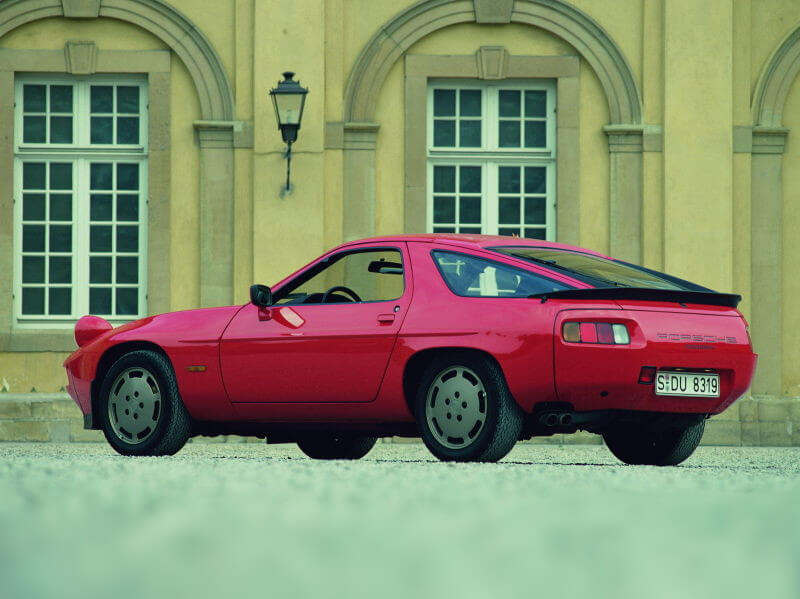928
(1977 – 1995)
Development of the 928 began in late 1971. Porsche believed that the venerable air-cooled 911 could not continue indefinitely, given ever restricting regulations on noise, emissions, and the crash worthiness of rear-engined cars. Also, Porsche saw a need for a car to fill the lucrative, horsepower-driven American market, where half of all their new car sales were being made.
Power plants considered for the 928 project included a V6, but an all-aluminium 4.5 litre, 16-valve SOHC V8, designed by Porsche became the chosen power plant. Using Bosch K Jetronic fuel injection, it produced 240Hp. This was the first engine designed specifically to use the K Jet system. Testing of the various drive train and suspension components was carried out in 911, Mercedes, Opel and Audi bodies. Porsche engineers went to great lengths during this process, as the donor cars sometimes had to be shortened, lengthened or widened to accommodate the 928 drive train and suspension. Later full-scale models and prototypes were given extreme testing in desert tests in Africa, and ice tests in Finland.
At its unveiling at the Geneva motor show in 1977 the car stunned the world and received critical acclaim. The 928 was promptly awarded Car of the Year for its many innovations. Among these were the all aluminium engine block and cylinder heads. The “Weissach Axle” (named after the Porsche R&D centre where it was created), also achieved much praise. The goal of the Weissach axle was to eliminate “lift-off” over steer by allowing the rear suspension to actually adjust itself during cornering and also on hard acceleration. The Weissach axle is one of the most noted features of the 928, and was eventually adapted across the model line-up. The front engined car employed a torque tube and rear mounted transaxle assembly to achieve a near perfect 50/50 weight distribution front to rear.
The 928 was available with the choice of a 3 speed Mercedes Benz sourced automatic transmission or an all Porsche 5 speed manual.
928 S
(1980 – 1985)
Displacement was increased to 4.7 litres and horsepower rose to 300Hp. Along with the horsepower increase came bigger brakes, firmer suspension and new spoilers front and rear. The 928 S ran alongside the original 4.5 928 till that car was phased out in 1982. In 1983 Bosch LH Electronic fuel injection was fitted to the range. Power increased to 310Hp. In England the car was released as a 928 S2, this was not done in Australia. 1984 the 928 was equipped with a new stronger and more economical 4 speed automatic released, still from Mercedes Benz.
928 S3
(1986)
1986 in Australia saw the introduction of unleaded petrol. It also saw the release of Porsche’s new pollution friendly engines. The 928 received a heavily revised 4 cam, 32 valve, 5 litre V8. Equipped with catalytic converters and lambda control. Even with the added displacement, due to the stricter emission controls, power for Australian cars dropped to 288Hp. This lower horsepower figure was offset by a higher torque curve, and max power was made lower in the rev range. The new engine was fitted into the same body as previous 928’s, some cars came fitted with larger Brembo fixed callipers, though not all. This car only ran for one year, and was never officially called the S3 outside of the factory.
928 S4
(1987 – 1991)
1987 saw the first real cosmetic update of the exterior of the 928 in ten years. New front and rear bar covers, driving lights that mimicked the then new 964. The rear taillights were bigger and the rear profile was changed significantly. These updates brought the car into line with Porsche’s new corporate image. The engine received a new, more compact inlet manifold and power rose to 316Hp.
1989 saw another major change to the inside of the cars, an electronic display in the dash was added, with trip computer and tyre pressure monitoring (RDK). RDK (Ruffen Drukken Kontrol) was another world first for Porsche, it allowed the tyre pressures to be monitored inside the cabin, alerting the driver through a display in the dash if pressure dropped below a set value.
928 GT
(1991 – 1992)
The sporting 928, fitted with the 5 speed manual gearbox as opposed to the much more common auto. Theses cars also received sports seats, a higher red line by 200 RPM and power rose to 326Hp. PSD (Porsche electronic limited Slip Differential) was also fitted. Employing an electric pump and hydraulic fluid, it could vary the amount of pressure exerted on the differential clutch plates, as different driving conditions arose. By sensing the wheel speed difference across the rear axle, PSD could effectively lock the differential to force drive to the non driving wheel.
928 GTS
(1992 – 1995)
The 928 was nearing the end of its life, sales were down, and Porsche as a company was haemorrhaging money badly. The Boxster was already in the pipeline and it had been decided that the 928 would have to make way. So rather than fade away, the 928 went out with a bang.
Enter the GTS, this became the ultimate 928. Everything that customers had asked for was here. Engine capacity was increased to 5.4 litres and power to 350Hp. The rear guards were flared to allow for bigger rubber to handle that extra power. The range-wide ‘Cup One’ alloys were fitted to the car, along with sleeker ‘Cup’ mirrors. A new range of exterior colours were available, and equipment levels were the best yet – to travel in a 928 GTS was to travel in the lap of luxury. Every gadget was there: from trick Blaupunkt stereo, to climate control air conditioning, electric heated seats with memory and cruise control.
The last 928 ever to be produced was an automatic GTS, finished in sample Lime Green metallic with sample purple leather interior, with matching purple carpets and dash. A fitting end to a model that personified excess.

